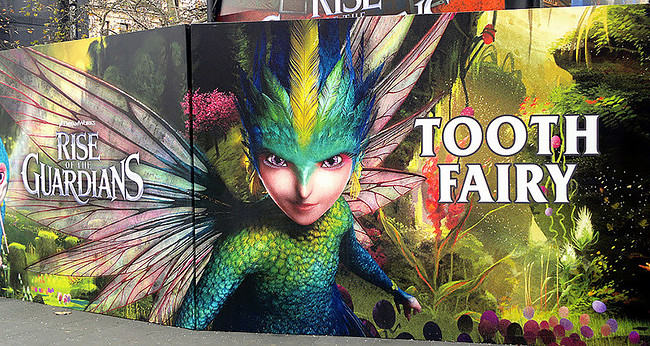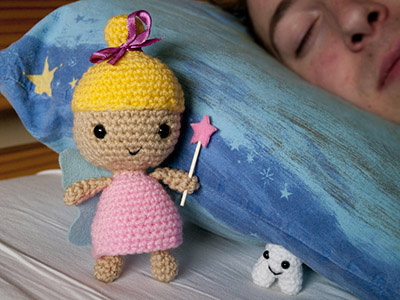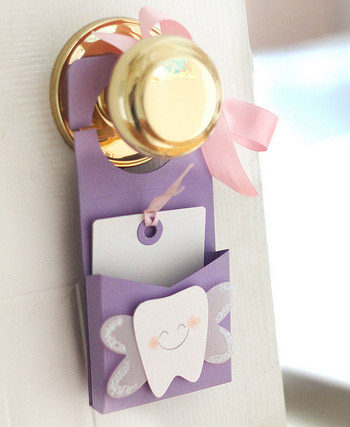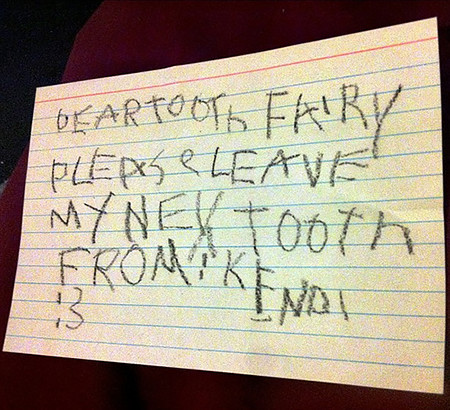
Kelly J. Baker
My six-year old’s smile is missing yet another tooth. She lost her second incisor three weekends ago, and all that remains is a gaping hole where it used to reside. Since the start of Kindergarten, she’s lost four teeth in total. Her adult teeth are crowding into the small gaps left behind. The teeth that she fiercely cut as a baby are disappearing one by one, and now, she spends much time wiggling her loose teeth to determine whether they are ready to pull out. Wiggle, creak, wiggle, creak, wiggle, creak. Eventually, she cajoles me into offering a second opinion on a tooth’s looseness. I carefully put my fingers in her mouth and gently push her tooth. I flinch visibly. Loose teeth are not my least favorite component of motherhood, but they come close. Teeth are the stuff of my nightmares. Since I was a child, I’ve had recurring dreams in which all my teeth fall out. Sometimes, I lose them gradually, but in other dreams, I open my mouth and all my teeth rain down. Unsurprisingly, I watch my daughter in abject horror as each tooth comes out of her mouth. Previously rooted into her gums, the tooth is now in her hand. Blood and viscera follow. I shudder. My kid laughs about overblown reactions to something as small and insignificant as a tooth.

The loss of teeth, however, is not insignificant as I might hope. The shed tooth is the material evidence of growing up. Baby teeth replaced by their adult counterparts. The last trappings of infancy disappear as children make that slow climb to adulthood. Losing a tooth is a rite of passage in childhood, and thus, there are beliefs and rituals surrounding these particular moments of tooth loss. According to Michael Hingston, rituals about the loss of baby teeth are global. Teeth are tossed on roofs and in fires, buried and hidden, or swallowed by the child, the mother (nope!), or even an animal. In the U.S., we have the Tooth Fairy, who collects the teeth from under pillows while children sleep soundly. In exchange for teeth, she leaves behind gifts, most often money (the current rate of exchange is $3.70 a tooth), but sometimes toys or even jewelry.
The Tooth Fairy is a one of the common myths of childhood alongside Santa (and his surveillance elves) and the Easter Bunny. She’s also the only female figure in the so-called pantheon of American childhood beliefs. Hingston writes that the Tooth Fairy emerges as a combination of maternal fairies made popular by Disney and rituals of offering of baby teeth to a rat or mouse (the Tooth Moose). The goal of offering the child’s tooth to rodents is the hope that the child’s incoming teeth would be as strong as those of the receiving creature. It was a magical rite based on imitation. The Tooth Fairy, however, offers no such guarantee of strong teeth but rather a monetary prize to compensate for the loss. She trains children in market exchange, which seems fitting for an American myth. She’s a creature of transition and capitalism.
The Tooth Fairy is a relatively recent addition to American childhood myths unlike Santa or the Easter Bunny. Anthropologist Cindy Dell Clark traces her origins to the U.S. in the nineteenth century, a combination of “shed-tooth rituals” from a variety of immigrant groups.[1] Her first appearance in print is a 1927 play by Esther Watkins Arnold, but she gained wider attention in the U.S. in the 1970s. In 1993, Rosemary Wells, a professor at Northwestern University Dental School, founded the Tooth Fairy Museum in her home (now defunct) displaying artifacts of the Tooth Fairy’s work collecting teeth as well as a wide array of Tooth Fairy dolls. In 2012, the Tooth Fairy was one of the main characters in the film Rise of the Guardians, based on the William Joyce’s The Guardians of Childhood books. The film, one of my daughter’s favorites, focuses on the belief, magic, and enchantment as crucial elements of childhood. Belief in Santa, the Easter Bunny, and the Tooth Fairy (as well as the Sandman and Jack Frost who appear in the film) keep nightmares away. Children sleep peacefully with good dreams as long as they believe in these guardians. They are protected because they believe. Belief, the film notes, keeps childhood free from the danger of reality. If only, we protect our children so easily.
This emphasis on belief in myths of childhood fascinates and troubles me. As a scholar of religious studies, I’m always curious about the evocation of belief and the command to believe. I write about how people embody belief through artifacts, ritual, and bodily discipline. What does it mean that children are encouraged to believe in the Tooth Fairy and the pantheon of childhood beliefs? What do these myths do for children and adults? As a parent of two small children, I’m also troubled. I reluctantly participate in our culture’s insistence that the Tooth Fairy and Santa and the Easter Bunny are required parts of childhood.

I wanted to avoid all three because I didn’t want to lie to my children. What I didn’t realize was how impossible avoidance would be. Everyone around me wants my children to believe that the childhood myths are real. Belief becomes required and not optional.
Grandparents tell my kids about Santa who brings gifts to good girls and boys. The cashier at Publix supermarket asked my daughter if the Tooth Fairy visited and then provided lengthy explanation of what happens to all those baby teeth (Castles of teeth! Recycled teeth for babies! Keep brushing, kids!). My mother even made my daughter a pillow for her lost teeth that hangs on her bedroom door. This inadvertent Tooth Fairy hates to admit that the pillow does make the exchange easier (but my daughter only gets $1 a tooth). Parents of my children’s friends signal that the Easter bunny visited their homes with baskets full of candy and toys.
What most surprises me is that I hadn’t thought about the Tooth Fairy very much until I became a reluctant player in the myth. As I groggily removed a tooth from the pillow and replaced it with cash, I wondered why there is such cultural importance attached to a fairy, a jolly elf, and an egg-hiding bunny. The Tooth Fairy didn’t really exist to me until I had to be her, and psychologists found that she doesn’t really exist for children until they lose a tooth.[2] While Santa or the Easter Bunny are neatly tied to particular holidays that arrive yearly, the Tooth Fairy comes and goes with each lost tooth. There’s no pattern or specific time for her arrival, so she requires more “parental involvement to support belief than does the Easter Bunny or Santa Claus.”[3] This might explain why some parents write Tooth Fairy letters to their children, sprinkle glitter on window sills, or throw themselves at various DYI projects.
Anthropologist Cindy Dell Clark asked children about the Tooth Fairy as well as interviewed their mothers to see how they interpreted the myth. Clark found that this particular myth helps children manage the trauma of losing a tooth. Tooth loss, she writes, is “a rich metaphor for loss, retreat from power, and vulnerability,” so the Tooth Fairy emerges as a ritual that turns trauma and loss into a positive experience (8-9). Rather than just getting rid of a part of you, your lost tooth is entrusted to the care of the Tooth Fairy. Moreover, the children Clark interviewed understood that shedding teeth meant they were becoming more grown up. Their mothers, however, played Tooth Fairy in the hopes to keep their children still “little.” By presenting and participating in an enchanted ritual, these women longed to keep their children child-like for a bit longer. The belief in the magic of the Tooth Fairy signaled that these kids were not quite adults yet. These mothers tried to keep scary reality away by creating a “childish world of make-believe” (19). Make-believe appears a safe alternative to life’s dangers.

What is striking is that adults work to create fantasies for children and then forget that we created them. Instead, adults pass the blame onto children, who we claim cannot distinguish easily between fantasy and reality. Even the research on children, Jacqueline Woolley writes, still persists with these assumptions today. Researchers, like many parents, imagine that children live in worlds of fantasy not reality and set up experiments that only confirm their bias. Scholars describes as children as participants in “fantastical thinking” who assert magical causes to the physical ways the world works rather than “thinking about fantasy,” which includes knowledge about the difference in status between what is real and what is fantasy. By engaging recent studies in child development, Woolley argues that children can distinguish between fantasy and reality, but adults feel more comfortable thinking that they can’t.
The Tooth Fairy becomes an interesting space of negotiation between adults and children. Adults create an elaborate belief system (the Tooth Fairy) and ritual (hiding the shed tooth under the pillow), tell children about it, exhort them to believe, and exchange teeth for money. Basically, we make up a myth and ritual in the hopes that children and childhood function in certain ways. These childhood myths reflect adult visions of childhood without reckoning what childhood is like for children. Children’s participation in the Tooth Fairy myth becomes the evidence that children believe in fantasy, which adults, then, claim is key component of childhood. We create the system, enforce it, and then, use our creation to make assumptions about what children are. Part of the problem is that researchers, and adults more generally, are unsure how to engage children beyond our culture’s limited imagination of what they can be. Susan Ridgely rightly points out that children appear in scholarship as “reflections of adult concerns about the present” or as “projections of adult concerns in the future.”[4] We have yet to recognize the agency of children as they negotiate their own lives.
Children believe in the Tooth Fairy because of the adult insistence that she’s real. The Tooth Fairy becomes a method to claim that childhood can be safe and protected. That we can somehow stave off the process of growing up by placing teeth under pillows. That they’ll stay small just a little while longer. No matter what parents do, we can’t save them from this thing called life.
Yesterday, my daughter lost yet another tooth. “I want to see the Tooth Fairy,” she told me. “Why?,” I asked. She hesitated and then said, “She’s a fairy. I would love to see a fairy.” I gave her a tight hug. After she was tucked in her bed, I thought about how she seemed more grown-up every day and how I couldn’t wait to see what she becomes. She won’t remain little no matter how much I wish time would slow down. The Tooth Fairy can do nothing to change that, and that’s just fine.
Kelly J. Baker is a freelance writer with a religious studies PhD who covers higher education, gender, labor, motherhood, American religions, and popular culture. She is the author of Gospel According to the Klan: The KKK’s Appeal to Protestant America (2011) and The Zombies are Coming! (2013). She can be followed @kelly_j_baker.
NOTES:
[1] Cindy Dell Clark, Flights of Fancy, Leaps of Faith: Children’s Myths in Contemporary America, Chicago: University of Chicago Press, 1995, 10.
[2] Norman Prentice et al, “Imaginary Figures of Early Childhood: Santa Claus, Easter Bunny, and the Tooth Fairy,” American Journal Orthopsychriatry, 48:4 (October 1978), 2.
[3] John R. Blair et al, “Children’s Belief in Santa Claus, Easter Bunny and Tooth Fairy,” Psychological Reports, 46 (1980), 694.
[4] Susan B. Ridgely, “Introduction,” in Study of Children in Religions: A Methods Handbook, (NYU Press, 2011), 1.
